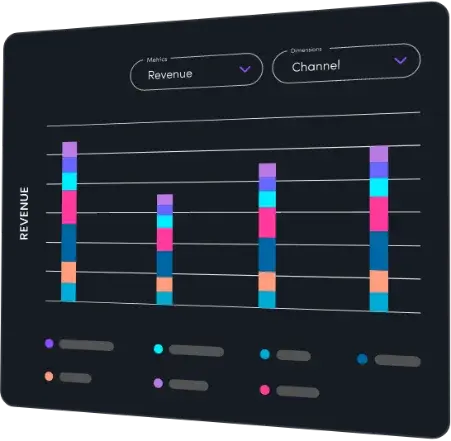
Attribution Report Example: A Professional Guide to Understanding Marketing Impact
Attribution reporting has evolved from a nice-to-have to a strategic essential. With today’s customers interacting across multiple platforms, knowing which touchpoints drive engagement and conversions is critical. This blog breaks down attribution reporting with real-world examples, proven models, and best practices to help marketers turn scattered data into strategic clarity.
Many companies face the same challenge: they invest in marketing, but they are unsure which efforts actually deliver results. Traditional reporting methods often fall short, making it difficult to track how customers move across touchpoints and what truly drives conversions.
With marketing happening across so many channels: websites, paid ads, email, social media, and more, understanding the full customer journey has become increasingly complex. Businesses have relied on fragmented data and assumptions, leading to misaligned strategies and wasted budgets.
This is where marketing attribution reporting has changed the game. It provides a structured way to assign credit to each touchpoint in the customer journey. Companies now use it to uncover what influences a lead, what drives a sale, and what deserves more investment.
Direct-to-consumer brands use attribution reporting to identify which ad campaigns lead to purchases. Business-to-business teams rely on it to trace which touchpoints move prospects through a long sales cycle. Ecommerce and retail brands turn to it for insight into multichannel buying behavior.
With attribution reporting in place, these businesses have shifted from guesswork to clarity. They no longer react to results: they plan for them. But has marketing attribution really become the game changer that companies claim it to be? Let us understand the concept of marketing attribution.
Understanding Attribution Reporting
What Is an Attribution Report
An attribution report is a data-based analysis that shows which marketing touchpoints contribute to a specific outcome. These outcomes can include lead generation, product purchases, or sign-ups.
It tracks how potential customers engage across multiple channels before converting. Each channel is evaluated based on its influence on the final decision. The goal is to assign value to each step in the customer journey.
By using attribution reports, marketers can move away from isolated metrics and gain a full-funnel view. This helps in evaluating performance more accurately and making better investment decisions.
Attribution reporting offers several practical benefits that support strategic marketing. It helps teams understand, improve, and justify their efforts with data.
Here are a few ways it helps:
- Optimize marketing spend by identifying high-performing channels.
- Improve campaign strategy based on real user behavior.
- Understand customer journeys across multiple touchpoints.
- Align sales and marketing efforts using shared attribution data.
- Justify ROI with data-backed decision-making.
How To Create An Attribution Report
Creating an attribution report involves structured planning, accurate data collection, and clear goal-setting. A well-executed report helps uncover how each marketing effort contributes to your business outcomes.
- Step 1: Define Your Objective:
- Step 2: Set Up Tracking Across Channels:
- Step 3: Select an Attribution Model:
- Step 4: Gather and Organize Data:
- Step 5: Analyze Touchpoint Impact:
- Step 6: Visualize Results:
- Step 7: Apply Insights To Strategy:
Start by identifying what you want to measure. This could be lead generation, sales, sign-ups, or customer retention.
Implement tools that track engagement on each marketing platform. Use analytics software, customer relationship management systems, and UTM parameters for consistent data collection.
Choose a model that aligns with your business goals and sales cycle. Consider the length of your funnel and the number of touchpoints involved.
Collect performance metrics from each channel. Ensure data is clean, consistent, and time-stamped to reflect user movement accurately.
Review how each touchpoint contributes to the overall conversion. Look for patterns in how prospects interact across channels.
Create dashboards or reports that display attribution findings. Use charts, tables, and filters to make the data easy to interpret.
Use the findings to refine your campaigns. Shift budgets, test new content, and invest more in high-performing touchpoints.
Pro Tip- Always validate your attribution report against actual business results. Attribution tools provide strong indicators, but pairing them with sales data adds deeper accuracy.
Attribution Report Examples
Example 1: How DiGGrowth Helped a Leading Finance Company Maximize Marketing ROI
A prominent finance company was investing in multiple marketing channels but lacked visibility into which ones were influencing conversions. Their team used paid advertising, email campaigns, webinars, blog content, and direct sales outreach. However, without attribution reporting, they could not connect these efforts to actual customer behavior.
DiGGrowth implemented a comprehensive multi-touch attribution framework. The system tracked all user interactions, from initial website visits to final sales consultations. It integrated data from customer relationship management software, email platforms, advertising tools, and event systems.
After analyzing the data through a position-based attribution model, DiGGrowth uncovered valuable insights:
- Most high-value leads first engaged with long-form blog content focused on financial planning.
- These users typically signed up for a webinar as the next step in their journey.
- Email follow-ups after webinars played a critical role in moving prospects toward consultations.
- Paid search had a strong influence only at the bottom of the funnel.
Based on this report, the company shifted its content strategy to focus more on educational content and webinar promotion. It also adjusted its email workflows to better align with the interests shown during early interactions.
The Impact
- Lead quality improved due to better nurturing and targeting.
- Webinar sign-ups increased by 40 percent within the first month.
- Conversion rates from lead to opportunity rose by 27 percent.
- Cost per acquisition dropped by 19 percent due to better budget allocation.
By understanding how each channel contributed to the customer journey, the company built a more efficient and scalable marketing engine.
Example 2: Solving Channel Confusion for a SaaS Enterprise
The Challenge
A global software provider was running campaigns across paid social, search, webinars, and email. Despite high traffic and lead volume, conversions remained inconsistent. Their team could not pinpoint which touchpoints were actually driving qualified sign-ups or influencing the buyer journey.
The Solution
DiGGrowth deployed a multi-touch attribution model using time decay logic. This helped the team track the influence of every channel from first interaction to final conversion, with more credit assigned to recent touchpoints. Data from their CRM, ad platforms, and content engagement was unified into one dashboard.
The Findings
- Early-stage leads entered mostly through product-focused organic content.
- Mid-funnel engagement spiked through comparison guides promoted via LinkedIn.
- Conversion rates increased when email follow-ups were triggered post-webinar.
- Paid search had limited impact on early engagement, but supported closing deals
The Outcome
With this insight, the company revised its budget distribution, reducing investment in top-funnel paid campaigns and increasing spend on webinar promotion and targeted email flows. The changes led to:
- 33 percent increase in trial-to-paid conversions
- 25 percent improvement in lead qualification
- Better alignment across sales and marketing touchpoints
Pro Tip- When reviewing attribution reports, go beyond top-level metrics. Analyze user paths to see how specific content formats, timing, and engagement patterns influence decision-making. This will reveal hidden opportunities across the funnel.
Best Practices For Attribution Reporting
Maximizing the effectiveness of attribution reporting requires following a set of strategic practices. These best practices ensure accurate data tracking, strategic alignment, and actionable insights for optimizing marketing campaigns.
1. Align Metrics With Business Goals
Attribution reporting must directly tie to your business goals. If you do not align the metrics with objectives like lead generation, revenue growth, or customer retention, your reports will not provide actionable insights. Every metric you track should serve a clear purpose.
- Set clear marketing goals like lead generation or sales.
- Choose attribution models that support those goals.
- Track KPIs like return on investment (ROI), customer lifetime value (CLV), and cost per acquisition (CPA).
For example, if your goal is to generate more qualified leads, choose an attribution model that highlights the early stages of the funnel (e.g., first-touch attribution). If you’re focused on driving sales, last-touch or position-based models might be more beneficial.
2. Use Consistent Tracking Across All Channels
Accurate attribution requires consistent data across all marketing touchpoints. By ensuring standardized tracking methods, you can avoid discrepancies between channels and platforms, giving you a holistic view of the customer journey.
- Implement UTM parameters for consistent tracking across campaigns.
- Use conversion tags on all digital touchpoints (email, social media, paid ads).
- Integrate analytics tools for comprehensive cross-channel tracking.
3. Integrate Systems for Unified Data
Attribution reporting is only as strong as the data behind it. When customer insights are scattered across disconnected platforms, marketers struggle to form a complete picture. Fragmented systems lead to assumptions, not answers—and that weakens strategy.
Integrated systems bring structure to the chaos. When tools like CRM platforms, marketing automation software, and analytics dashboards are connected, the result is a unified, accurate, and actionable view of customer journeys. This seamless integration is critical for assigning value to each touchpoint and understanding how marketing actually drives revenue.

DiGGrowth takes this a step further. Built with a customer-first approach, it captures, stitches, and organizes data from every touchpoint. From ad clicks to email opens, website engagement to demo requests—everything is tracked and mapped against business outcomes like pipeline and revenue. The platform eliminates the guesswork by revealing the full journey behind every conversion.
Instead of juggling multiple tools or relying on isolated metrics, marketers using DiGGrowth gain a centralized source of truth. With this kind of unified visibility, attribution reporting becomes more than just a performance snapshot—it becomes the foundation for smarter decision-making.
This level of integration transforms raw data into strategic insight, allowing marketing teams to prioritize what works, cut what doesn’t, and invest where it matters most.
4. Test Multiple Attribution Models
There is no one-size-fits-all approach when it comes to attribution. Each model offers a unique lens through which to view marketing performance, and the right fit often depends on your sales cycle, customer journey complexity, and campaign objectives.
Relying solely on one model can create a skewed perspective. For instance, first-touch attribution highlights early awareness but may ignore nurturing efforts. Last-touch attribution focuses on conversion but overlooks brand-building channels. Testing different models provides a fuller understanding of how each channel contributes to conversion and helps uncover hidden drivers of performance.
This is why it is essential to evaluate various models side by side. Some may reveal how paid ads drive initial interest, while others highlight how email nurtures leads into customers. By comparing results, patterns start to emerge—and those patterns inform smarter budget allocation and campaign planning.
Below is a breakdown of common attribution models and how they assign value across the customer journey:
| Attribution Model | Description | Best For |
|---|---|---|
| First-Touch Attribution | Assigns full value to the first touchpoint that initiated customer interaction. | Brand awareness campaigns |
| Last-Touch Attribution | Gives complete credit to the final touchpoint before a conversion. | Short sales cycles and promotions |
| Linear Attribution | Distributes equal credit across all touchpoints in the journey. | Multi-step buying processes |
| Time Decay Attribution | Prioritizes recent touchpoints by giving them more weight. | Urgent or time-sensitive conversions |
| Position-Based Attribution | Credits the first and last touchpoints most, with the rest receiving less. | Long sales cycles with multiple interactions |
| Custom Attribution | Uses a business-specific formula to assign value to touchpoints. | Advanced teams with defined attribution models |
6. Align Teams Around Attribution Goals
Attribution reporting is not just a marketing function—it is a collaborative process that requires alignment across departments. When teams work in silos, reporting lacks consistency, and critical insights get lost between tools, metrics, and expectations.
To get the most value from attribution, marketing, sales, operations, and leadership need to align on a few key elements: what success looks like, how it is measured, and which touchpoints matter most. Shared goals, clear definitions, and mutual understanding ensure that attribution models are not only accurate but also actionable.
When all stakeholders have access to unified data and shared dashboards, attribution becomes a shared responsibility—not just a marketing metric. This creates accountability, encourages collaboration, and supports a more agile, data-driven culture.
Title: Aligning Teams Around Attribution Goals
- Marketing: Defines key touchpoints, campaigns, and lead sources
- Sales: Shares CRM insights, tracks lead quality and conversion patterns
- Ops/Analytics: Builds, integrates, and maintains reporting frameworks
- Leadership: Sets KPIs, aligns strategy with business goals
7. Regularly Audit and Optimize Attribution Strategy
Attribution reporting is not a set-it-and-forget-it process. As customer journeys shift and marketing strategies expand, your attribution model must evolve to stay relevant. Regular audits help identify discrepancies, outdated metrics, and tracking gaps that could lead to inaccurate conclusions.
By reviewing the performance of your attribution model periodically, you can uncover areas where data may be misaligned or touchpoints are undervalued. Updating your model to reflect current behaviors, new channels, or campaign objectives ensures your insights remain accurate and your strategy stays effective.
Short Code/Key Takeaways
- Choosing the right attribution model is critical to align data with business goals and funnel stages.
- Unified data from integrated systems leads to more accurate, actionable marketing insights.
- Testing multiple attribution models provides a clearer understanding of what drives conversions.
Conclusion
Attribution reporting is no longer just an option; it is an essential strategy for businesses seeking to optimize their marketing spend, improve the customer journey, and accurately measure ROI. Attribution reporting provides the clarity needed to understand how each interaction contributes to the final outcome.
You need data that speaks to real customer behavior, a strategy that adapts to changing dynamics, and systems that connect all the dots across various channels. Attribution reporting equips you with that clarity, helping you allocate resources more effectively and drive better business outcomes.
If you are ready to leave blind spots behind and take your marketing from guesswork to precision, DiGGrowth is here to help.
Our advanced attribution tools and analytics will empower you to track every touchpoint, optimize campaigns, and boost conversions. Connect with our experts at info@diggrowth.com and take your marketing from guesswork to precision.
Sources
https://knowledge.hubspot.com/reports/create-attribution-reports
https://knowledge.hubspot.com/reports/understand-attribution-reporting
https://support.google.com/google-ads/answer/1722023?hl=en
Ready to get started?
Increase your marketing ROI by 30% with custom dashboards & reports that present a clear picture of marketing effectiveness
Start Free Trial
Experience Premium Marketing Analytics At Budget-Friendly Pricing.

Learn how you can accurately measure return on marketing investment.
Additional Resources
How Predictive AI Will Transform Paid Media Strategy in 2026
Paid media isn’t a channel game anymore, it’s...
Read full post postDon’t Let AI Break Your Brand: What Every CMO Should Know
AI isn’t just another marketing tool. It’s changing...
Read full post postFrom Demos to Deployment: Why MCP Is the Foundation of Agentic AI
A quiet revolution is unfolding in AI. And...
Read full post postFAQ's
Businesses often struggle with data fragmentation, choosing the right attribution model, and integrating cross-channel insights. These challenges can lead to inaccurate conclusions and misguided marketing strategies if not addressed properly.
Attribution reporting aligns marketing and sales teams by providing shared insights into customer touchpoints. This ensures both teams work toward common goals, optimizing lead nurturing, improving conversions, and enhancing customer relationship management strategies.
Yes, small businesses can gain significant insights from attribution reporting, helping them prioritize marketing efforts, reduce waste, and focus their limited budget on high-performing channels, improving overall ROI and growth potential.
Attribution reports should be reviewed regularly—ideally, on a monthly or quarterly basis. This allows businesses to adapt to evolving customer behavior, track changes in channel effectiveness, and continuously optimize their marketing strategy.
While advanced tools provide comprehensive insights and efficiency, basic attribution can be done with simpler analytics platforms. However, advanced tools offer better data integration, more attribution models, and a clearer picture of marketing performance.


